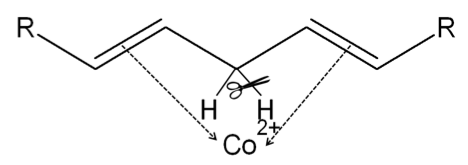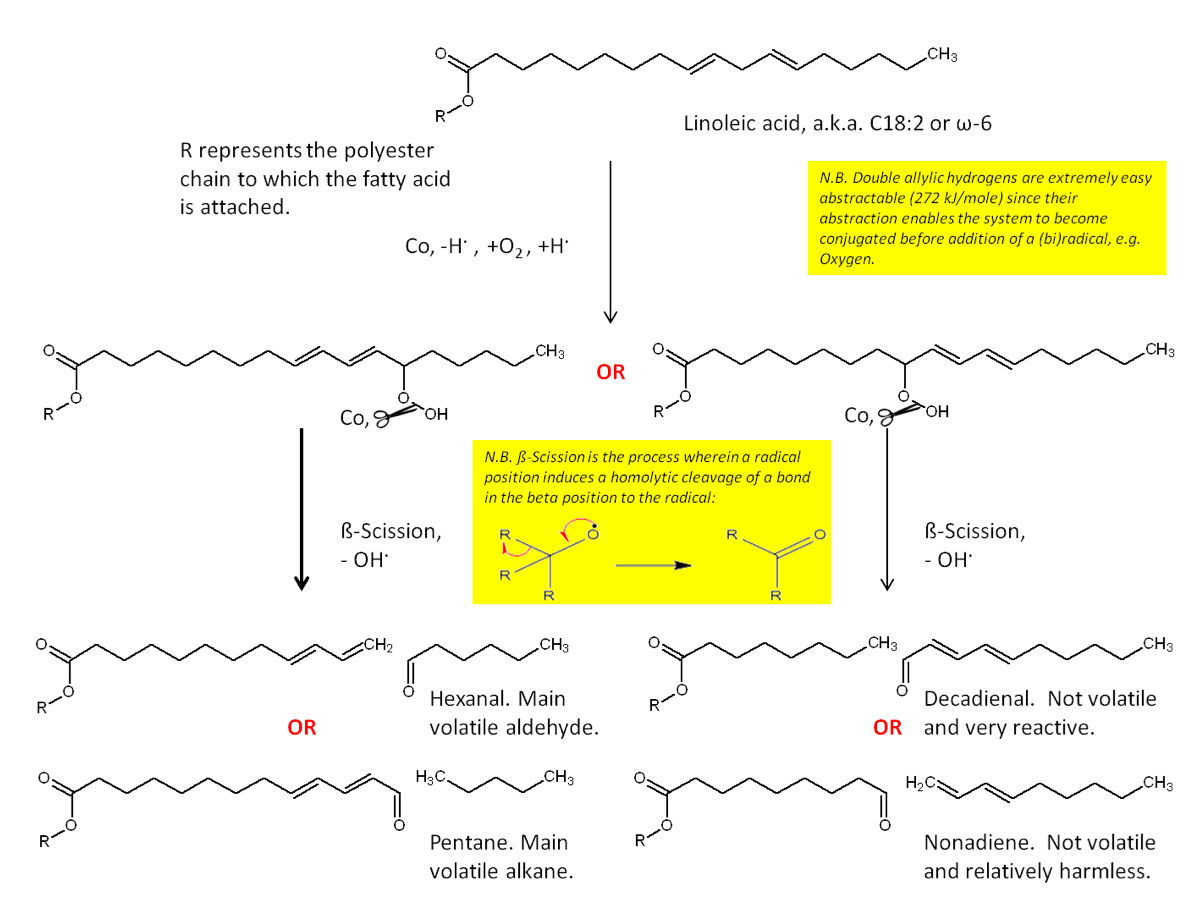深度剖析醇酸漆的干燥原理解读

Do most of us care how an alkyd paint dries?
Probably not. Just sit back and watch paint dry. But it is not so boring as the well-known expression states. Quite to the contrary.
In fact, a lot of interesting chemistry is taking place the very moment you are watching. It all starts out with realizing that the unsaturated fatty acid chains are the actual crosslink sites. Just as the two-component systems have their carboxylic acid, hydroxyl and/or isocyanate groups, the alkyd has its fatty acid groups. Some call an alkyd a fatty acid modified polyester, while real alkyd fans on the other hand call a polyester an oil-free alkyd.
Fatty acids, especially Linoleic acid, have a so-called double allylic CH2 moiety. The energy needed for abstraction of a hydrogen is already very low at 63 kCal/mole, but complexation of these double bonds with a bivalent Cobalt ion will even drastically lower this bond dissociation energy (BDE):

Figure 1. Complexation of linoleic acid with Cobalt.
My personal estimate is that the final BDE will be something like 45 – 55 kCal/mole. Other drier metals like Iron with special ligands as in Borchi® Oxy-Coat will decompose the hydroperoxide formed (see below) but will not be as effective in assisting making them. The reason could be steric/electronic hindrance by the very same complex ligands that makes them excellent hydroxide decomposers.
Interestingly, the hydroperoxide decomposing capabilities of these heavily complexed metals was the reason for their use in laundry detergents (OMO or Persil Power) in the past. Unfortunately, they were so effective that they did not only decompose the hydroperoxides but at elevated temperatures (for which they were not developed but sometimes used) also decomposed the laundry itself.
That is presumably why alternative driers like Iron and Manganese show an induction time. The good news is that this induction time allows for more oxygen to be taken up in the film, which results in more uniform drying throughout the process. Whereas MRI measurements show Cobalt clearly starts at the surface, Iron and Manganese clearly crosslink more uniformly from top to bottom.
Once the extremely low BDE has been effected, hydrogen will be split off at room temperature, probably assisted by radicals already present in the system or by hydrogen abstracting components in the solvent. In the case of an alkyd binder for instance, hydroperoxides are always present in the system. Once the Cobalt leaves the “scene of the crime,” the radical will rearrange from a double allylic into a single allylic conjugated carbon-centered radical that immediately reacts with the biradical Oxygen (3O2) as shown in Figure 2:

The above scheme shows how the smell of a drying alkyd paint can be explained. Hexanal and pentane. But it must be emphasized that this is a model system only, based on pure Linoleic acid (C18:2 NC). Nature is never pure, that’s what makes it attractive. The nearest one can get to pure Linoleic acid is Sunflower oil, resulting in a very well controlled initiation drying, one of the reasons it is so expensive.
The presence of more unsaturation makes the picture more complicated. Linolenic (C18:3 NC) acid for instance, can give rise to 3 times as much aldehydes, although Hexanal will always be the main one. The above scheme shows that apart from (doubly) unsaturated aldehydes in the split-off products, there can also remain some (doubly) unsaturated aldehyde in the trunk that remains on the polyester backbone.
These are the cause of another typycal alkyd paint phenomenon: yellowing. Although these unstaurated aldehydic moieties are not or only slightly coloured by themselves, their nitrogen analogues are. And aldehydes react with amines, which are omnipresent (e.g. toilet), to dark coloured Schiff bases.
So one could wonder, can an alkyd paint be made that doesn’t smell or yellow? Sure it can be made, for instance on Stearic (C18:0) acid, but don’t be surprised if it doesn’t crosslink. It will have no chemical resistance whatsoever.
Earlier in this article, I mentioned “initiation drying.” There is another type of drying that does not imply the use of doubly allylic hydrogen abstraction but more resembles the radical drying typical for acrylic type double bonds. This phenomenon is typical of conjugated double bonds. No hydrogen abstraction, no incorporation of heteroatoms, so no aldehydes. Summarizing: no smell and no yellowing:

This type of drying is sometimes referred to as propagation drying and has been extensively studied by Willem Muizebelt, et al. at AKZO-Nobel. Interestingly, since no oxygen is involved in this propagation drying, with the addition of anti-oxidant Tocopherol, it is extremely useful especially in thick layers.
Concluding, it can be stated that smell and yellowing of the most sophisticated coating resin, the alkyd, goes hand in hand with the complete process of drying and hence never can be avoided completely. Careful choice of raw materials can, however, minimize it to a level far below any legislation or observation.

